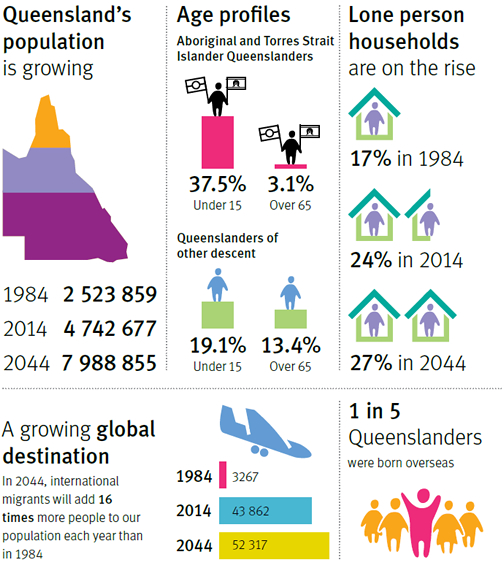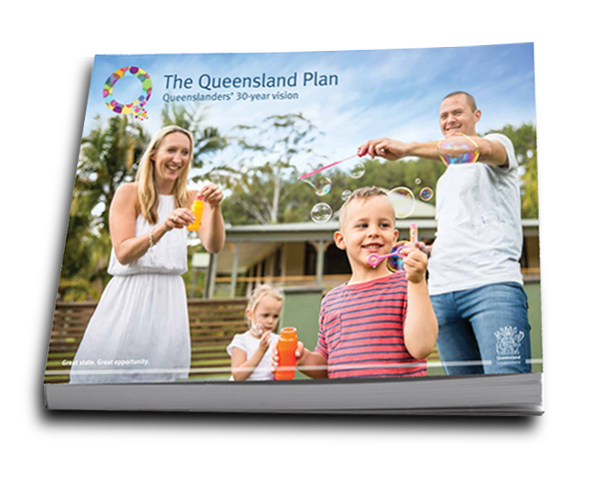People
On this page:
- Queenslanders’ vision for our people
- Why people is a foundation
- Spotlight on our people
- What Queenslanders want
- Achieving success
- Get involved
Queenslanders’ vision for our people
In 2044, our lifestyle and opportunities will be the envy of Australia and the world. Individual Queenslanders will have access to everything we need to make the most of our education, healthcare and job opportunities. We will support those who are in need or are disadvantaged and learn from each other – our seniors and young people, our neighbours and our Aboriginal and Torres Strait Islander peoples and their cultures.
Why people is a foundation
Unleashing individual potential maximises personal, community and economic outcomes. Read more on page 67 of The Queensland Plan.
Spotlight on our people

What Queenslanders want
The following goals highlight what Queenslanders said they wanted to be, do or achieve (in relation to this foundation). These goals are accompanied by the outcomes Queenslanders said they want to see. Read detailed descriptions of success factors in The Queensland Plan.
| Goal | What does success look like? |
|---|---|
G24 |
Our population growth keeps our communities liveable. |
| More people live and work in regional centres. | |
| Essential services are available across the state. | |
G25 |
Seniors share knowledge with younger generations. |
| Seniors remain healthy and active in community life. | |
| Seniors can age in their communities or neighbourhoods. | |
G26 |
We have broken the cycle of disadvantage and unemployment. |
| Minorities actively participate in community life. | |
| We have equitable access to qualifications and opportunities. | |
| G27 We attract bright minds to Queensland. |
Regions are attractive to bright minds and trained professionals.* |
| Queensland has a reputation for innovative excellence. | |
| There are more flexible learning options and opportunities for young people. |
*A top 10 priority identified by delegates at the Brisbane Summit.
Achieving success
The following targets and measures will help focus our efforts towards achieving success. The baselines have been sourced from existing data sets as a starting point for future reporting. Download The Queensland Plan for a detailed explanation of what the measures show.
T16 Inclusive participation
Queensland leads Australia in meaningful community and workforce participation especially for seniors and people with a disability.
T17 Indigenous opportunity
Aboriginal and Torres Strait Islander Queenslanders have the same opportunities and workforce participation as non-Indigenous Queenslanders.
T18 Liveability
Queensland is the best place to live in Australia.
| Primary measure | Starting point or baseline | ||||||||
|---|---|---|---|---|---|---|---|---|---|
Training and learningParticipation rates for further skills training and learning for Queenslanders 55–64 years of age. Source: ABS 6227.0.55.003 (2013) Education and Work, Australia - Additional data cubes, May 2013.
|
2.1% aged 55–64 years participate in formal study Baseline: Queenslanders participating in formal study aged 55–64 years, May 2013. |
||||||||
Employment—Queensland seniorsLabour force participation rate of persons aged 55 years or older, Queensland. Source: ABS Census of Population and Housing, 2011.
|
Baseline: Queenslanders aged 55 years or older participating in the labour force, 2011 and available by region (excludes labour force status of ‘not stated’). |
||||||||
Employment—DisabilityLabour force status by core activity need for assistance. Source: ABS Census of Population and Housing, 2011.
|
Baseline: Queenslanders aged 15–64 years with a core activity restriction, 2011 and available by region. Refers to a recorded core activity restriction that required assistance from another person to manage: self-care activities, body movements, and communication (excludes labour force status of ‘not stated’). |
||||||||
Employment—IndigenousEmployment rates of Indigenous and non-Indigenous Queenslanders by age group. Source: ABS Census of Population and Housing, 2011 (derived by Queensland Treasury and Trade).
|
Baseline: Employment rates of 15–64-year-old Queenslanders, 2011 and available by region. Unemployment rates include participants in Community Development Employment Projects. |
||||||||
LiveabilityProportion of Queenslanders who perceive Queensland as highly liveable in a state survey. Source: State survey.
|
Baseline to be created for 2014–15 through a state survey. |
| Secondary measure | Starting point or baseline | ||||
|---|---|---|---|---|---|
Disability and opportunityProportion of people with a disability or long-term health condition with year 12 equivalent or with non-school qualifications. Source: ABS 4430.0 (2013), Disability, Ageing and Carers.
|
Baseline: Queenslanders with a disability or long-term health condition, 2012. |
||||
Work-life balancePerceptions of work-life balance in a state survey. Source: State survey.
|
Baseline to be created 2014–15 through a state survey. |
||||
Childhood developmentThe proportion of five-year-old children developmentally vulnerable in two or more domains (AEDI), by region. Source: Australian Government (2013), A Snapshot of Early Childhood Development in Australia 2012 - Australian Early Development Index (AEDI) National Report.
|
26.2% of five-year-olds developmentally vulnerable. Baseline: Queensland five-year-olds who are developmentally vulnerable in one or more domain, 2012. |
||||
Children disadvantagedProportion of children and dependent students living in families where no parent is employed, by region. Source: ABS Census of Population and Housing, 2011.
|
13.5% of children and dependent students live in families with parents who were not employed. Baseline: Queensland's dependent children aged 0–14 years and dependent students aged 15–24 years living in families where parent(s) are not employed, 2011 and available by region. Includes parents in one parent and couple families who may not be in the labour force. |
Return to the foundations landing page to understand the purpose of the targets and measures or to select another foundation area to learn about.
Get involved
There are many ways you can help achieve our vision. Visit our Get involved page to read a few suggestions related to each foundation area.




